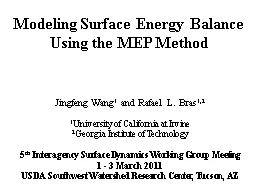

Jingfeng Wang 1 and Rafael L Bras 12 1 University of California at Irvine 2 Georgia Institute of Technology 5 th Interagency Surface Dynamics Working Group Meeting 1 3 March 2011 ID: 228830
Download Presentation The PPT/PDF document "Modeling Surface Energy Balance Using th..." is the property of its rightful owner. Permission is granted to download and print the materials on this web site for personal, non-commercial use only, and to display it on your personal computer provided you do not modify the materials and that you retain all copyright notices contained in the materials. By downloading content from our website, you accept the terms of this agreement.
Slide1
Modeling Surface Energy Balance Using the MEP Method
Jingfeng
Wang
1
and Rafael L. Bras
1,2
1
University of California at Irvine
2
Georgia Institute of
Technology
5
th
Interagency Surface Dynamics Working Group Meeting 1 - 3 March 2011
USDA Southwest Watershed Research Center, Tucson, AZSlide2
Rn
= E + H +
G
Land Surface Energy Budget
Partition of net radiation
R
n
into the fluxes of latent heat
E
, sensible heat
H
and ground heat
G
.Slide3
MEP Theory
Maximum Entropy Production Principle (MEP): an application of MaxEnt
to non-equilibrium systems with macroscopic transport of energy and matter.
Maximum Entropy Principle
(
MaxEnt
): a general method to assign probability distribution. The concept of entropy is
introduced as
a quantitative measure of information (or lack of it).Slide4
MaxEnt Formalism
Assigning probabilities
p
i
of x
i
by maximizing the information entropy
S
I
under generic constraints
F
k
,Slide5
Dissipation function
or entropy production function,
D
, is defined as,
satisfying the
orthogonality
condition,
according to
MaxEnt
,Slide6
D
is
maximized
under a
(nonlinear)
constraint,
D
is
minimized
under a
(linear)
constraint,Slide7
MEP
MethodFormulate a dissipation function or
entropy production function
in terms of the heat fluxes,
2. Find the stationary point of the dissipation function under the constraint of conservation of energy,
3. Solve the heat fluxes. Slide8
An Example
I
1
I
2
I
0
= I
1
+I
2
R
1
R
2
Formulate the
dissipation function
of the system in terms of the electric currents,Slide9
2. Find the stationary point of the dissipation function under the constraint of conservation
of electric charges,3. Solve the currents,
Lagrangian
multiplierSlide10
Physical Meaning of
D
thermal dissipation
thermodynamic entropy production
VoltageSlide11
MEP
Formalism of Heat FluxesA dissipation function
or
entropy production function is
formulat
ed as [
Wang and Bras
,
2011];,
I
s
=thermal inertia of conduction =
I
a
=thermal inertia of sensible heat transfer =
I
e
=thermal inertia of latent heat transfer (to be defined) Slide12
Formulation of
IaBased on the Monin-Obukhov
similarity
theory [
Wang and Bras, 2010];
,
a
,
b
,
g
2
are universal
empirical constants
[
Businger
et al
, 1971]. Slide13
Formulation of
Ie1.
I
e
is related to
I
a
due to the same turbulent
transport mechanism for heat and water vapor;
2.
I
e
is a function of surface soil temperature and
soil moisture as
E
depends on the two variables;
3. Water vapor right above the evaporating surface is in equilibrium with the liquid water at the soil surface.Slide14
I
e is postulated based on the above propositions:
T
s
= surface (skin) soil temperature,q
s
= surface (skin) specific humidity,
l
= latent heat of vaporization,
c
p
= specific heat of air at constant pressure,
R
v
= gas constant of water vapor, Slide15
MEP Model of
E
,
H
, G Slide16
Input of the MEP Model
Rn,
T
s
, q
s
or
q
s
E
,
H
,
G
n
et radiation
s
urface temperature
s
urface
humidity
s
urface
s
oil moistureSlide17
Properties of the MEP Model
Over a dry soil (
s
= 0
, hence
E
= 0
), the MEP model for the dry case is retrieved [
Wang and Bras
, 2009];
Over a saturated soil, the MEP Bowen ratio,
B
-1
(
s
)
, reduces to the classical equation [
Priestley, 1959, p.116], Slide18
Lucky Hills site of the Walnut Gulch Experimental Watershed during 11/16 – 12/26, 2007.Slide19
MEP Model of Transpiration
Over a canopy when Is=0
(hence
G
=0),
the MEP model gives explicit expressions of transpiration
E
v
and
H
,Slide20
Harvard Forest site during 19 August - 18 September 1994
.Slide21
MODIS-Terra for Sept., 2006
Remote Sensing Application
September 2006
Remotely sensed MEP model input
R
n
,
T
s
, and
q
s
(
T
d
) from MODIS on Terra satellite over Oklahoma [
Bisht
and Bras
, 2010]. The heat fluxes are in W m-2 and time in hours.Slide22
Conclusion
The MEP model provides an effective tool to estimate evapotranspiration (together with sensible and ground heat fluxes) using
field and remotely
sensed
surface
variables
as model input.
Acknowledgment:
This study is sponsored by ARO grant
W911NF-10-1-0236
and NSF grant EAR-0943356. Slide23
References
Bisht, G., and R. L. Bras (2010), Estimation of net radiation from the MODIS data under all sky conditions: Southern Great Plains case study, Remote Sens. Environ., 114, 1522-1534.
Businger
, J. A., J. C. Wyngaard, Y. Izumi, and E. F.
Bradle
(1971), Flux-profile relationships in the atmosphere surface layer,
J. Atmos. Sci., 28, 181-189.
Dewar, R. C. (2005), Maximum entropy production and fluctuation theorem,
J. Phys. A: Math Gen., 36, L371-L381.
Priestley, C. H. B. (1959),
Turbulent Transfer in the Lower,
The University of Chicago Press, Chicago, 130pp.
Wang, J., and R. L. Bras (2009), A model of surface heat fluxes based on the theory of maximum entropy production,
Water.
Resour
. Res., 45, W11422.
Wang, J., and R. L. Bras (2010), An
extremum solution of the Monin-Obukhov similarity equations, J. Atmos. Sci. 67(2), 485-499. Wang, J., and R. L. Bras (2011), A model of evapotranspiration based on the theory of maximum entropy production, Water. Resour. Res., in press.